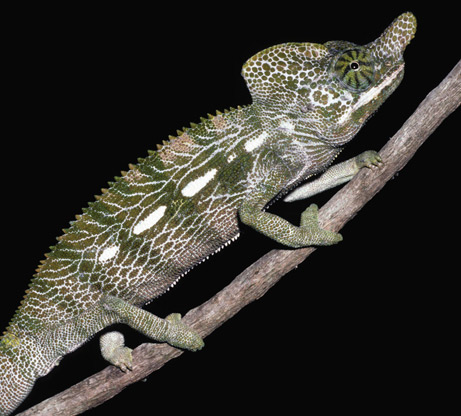 © June 30, 2008 - All rights reserved |
 Photograph by Christopher J. Raxworthy |
Members of a rare chameleon species all hatch in the same month, then die only four to five months later — making them the shortest-lived four-limbed vertebrates, a new study says.
Labord's chameleon had been identified in 1872 in the arid southwest of the island of Madagascar off the east coast of Africa. But it wasn't until 2003 that a zoologist noticed there was something strange about this particular species.
"It was just bizarre, because I could find only adults and no juveniles whatsoever," said study co-author Kristopher Karsten of Oklahoma State University.
"So I thought, Well, either my eye isn't trained very well to find these juveniles, or they're not there. And if they're not there, maybe that means that every one is the same age and they're an annual species."
After studying the chameleons for three more seasons, Karsten and his colleagues were certain that the entire population of Labord's chameleon (Furcifer labordi) turns over every year.
Coming Out of Its Shell
Labord's chameleons spend eight to nine months inside the egg. After hatching, the reptiles spend four to five months eating, mating, and reproducing.
Adding to their oddity, the lizards all hatch in the same month, November.
"Whether or not they die in the same month, that gets a little gray," said Karsten, whose team's study will be published in tomorrow's issue of the journal Proceedings of the National Academy of Sciences.
"Some individuals die earlier than others, because predators get to them first," he said. And others just naturally live a bit shorter or longer than their peers.
Jennifer B. Pramuk, curator of herpetology at New York's Bronx Zoo, said, "The lifespan and lifestyle of this small chameleon is more reminiscent of many insects than vertebrates.
"To put this in perspective, imagine living for only four months after being hatched from an egg. But during those few months of life, you grew quickly and reached sexual maturity," said Pramuk, who was not involved with the study.
"Even more bizarre, everyone in your species would be the same age. After mating and laying eggs, you and your peers would die en masse, and the cycle would begin again."
Cryptic and Elusive
It's not clear on why Labord's chameleons live such bizarre lives. It could be a response to the harsh environment of Madagascar.
"Most certainly it's the result of some evolutionary pressure. And it's worked for them up to this point, otherwise they would be extinct," study leader Karsten told National Geographic News.
There's one thing Karsten and company can be sure of: Their work is just beginning.
"We found this really cool thing that has now opened this whole myriad of questions we can explore," Karsten said.